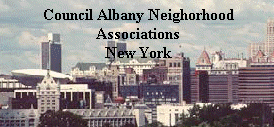Albany's Center Square is a product of
the people who live there and the amenities it has to offer.
Listed on the National Register of Historic Places, Center Square is a
tree-lined neighborhood bounded by Lark, State, Swan and Jay streets, and
taking in the upper portion of Lancaster Street between Lark and Willett
streets.
A short walk from restaurants, museums, boutiques, groceries, parks,
the library, schools and public transportation, the area appeals to people
of all ages.
"Center Square is like a small town in many ways and the property
values continue to go up," said Claire Yates, a 12-year resident.
"I love living here and can walk to work."
Row houses in the neighborhood, originally built as single-family
residences between 1850 and 1900, include facades of clapboard, brick and
brownstone. Today, many of the homes have been divided into studio,
basement and duplex apartments, yet the neighborhood still boasts a few
five-story brownstone mansions.
Unlike the grand houses on State, Lancaster and Jay streets, most of
the houses on Dove and Swan are modest brick or wood row houses originally
built for the working-class families who congregated around employment in
the neighborhood's breweries. There were more than four breweries in
Center Square at the end of the 19th century. The building that housed the
Amsdell Brothers Brewery, at the corner of Dove and Jay streets, is now
the Knickerbocker Apartments.
The closure of the Coleman Brothers Brewery at the turn of the century
made way for the matching Brides Row Houses on Chestnut Street between
Lark and Dove.
John G. Myers, owner of a department store by the same name, built the
identical brownstones (intended as homes for the offspring of the
neighborhood's well-to-do) across from the carriage houses that served the
grander homes on State Street. Over the years, many of the carriage houses
in this neighborhood have been renovated or torn down.
Because it's contiguous with the Empire State Plaza and businesses
along Washington Avenue and Lark Street, the streets in Center Square are
valued as free parking spaces, which can cause headaches for residents.
"If you walk down the street with a key in your hand, a car will
be following you," said Harold Rubin, who moved to the neighborhood
40 years ago.
"We, like many people who live here, have learned to use the
system," Rubin said. By that he means using the time when streets are
cleaned to do errands, returning just in time to get a spot when it's
legal to park again.
"However, if you come back late at night, you're in big
trouble," laughed Rubin. "Then you may have to park two or more
blocks away from your building."
The lack of available parking is one of the biggest reasons many young
families with children or very active lifestyles move out of the
neighborhood, said Yates, a past president of the neighborhood
association.
Center Square has the oldest neighborhood association in the city and
although the cobblestones have been paved with macadam and the slate
sidewalks covered with concrete, members strive to protect the area's
historic character.
Founded in 1958, the association tries to maintain the residential
integrity of the neighborhood by dealing with everything from approving
paint colors to pushing the city government to establish a resident
parking permit system.
"Our (membership) has almost doubled in the past few years,"
said its newly elected president, Judith Place, who is retired as the
Latin American librarian from the University at Albany library. "We
have 55 household members and continue to encourage more renters to join
as well. People who live or move to Center Square are very energetic and
organized. They are very committed to the neighborhood."
Like many urban neighborhoods, Center Square struggled in the 1960s and
'70s. But it experienced a resurgence in the 1980s, as the federal
government offered grant money and tax breaks to people who bought and
restored urban properties.
Thirty-somethings Elise Van Allen and her husband, Justin, moved to
Center Square from New Jersey in 2002.
"We fell in love with the architecture the first time we saw
it," said Elise Van Allen, vice president of the center's
association. "Everything that I am interested in is within walking
distance. I don't have to worry about getting into my car."
At a glance
Real estate values: Recent sales have ranged from $80,000 to $525,000.
Rentals: Approximately $450 for a small studio to more than $1,000 for
a two bedroom in excellent condition.
Schools: Children attend Philip Schuyler or Giffen for grades K-6;
Hackett for 7-8 (and some sections of grade 6); and Albany High School
9-12.
According to the 2003 State Report Card on Schools, the district spends
$10,992 per pupil and the student/teacher ratio is 13:1. Thirty-seven
percent of the high school graduates receive Regents diplomas.
Taxes: Properties are assessed a full value. Taxes include $14.75 per
$1,000 for city and county; $21.84 per $1,000 for school. Taxes for a
$200,000 house would be $7,318 a year.
Frances Ingraham Heins can be reached at 454-5502 or fingraham@timesunion.com
